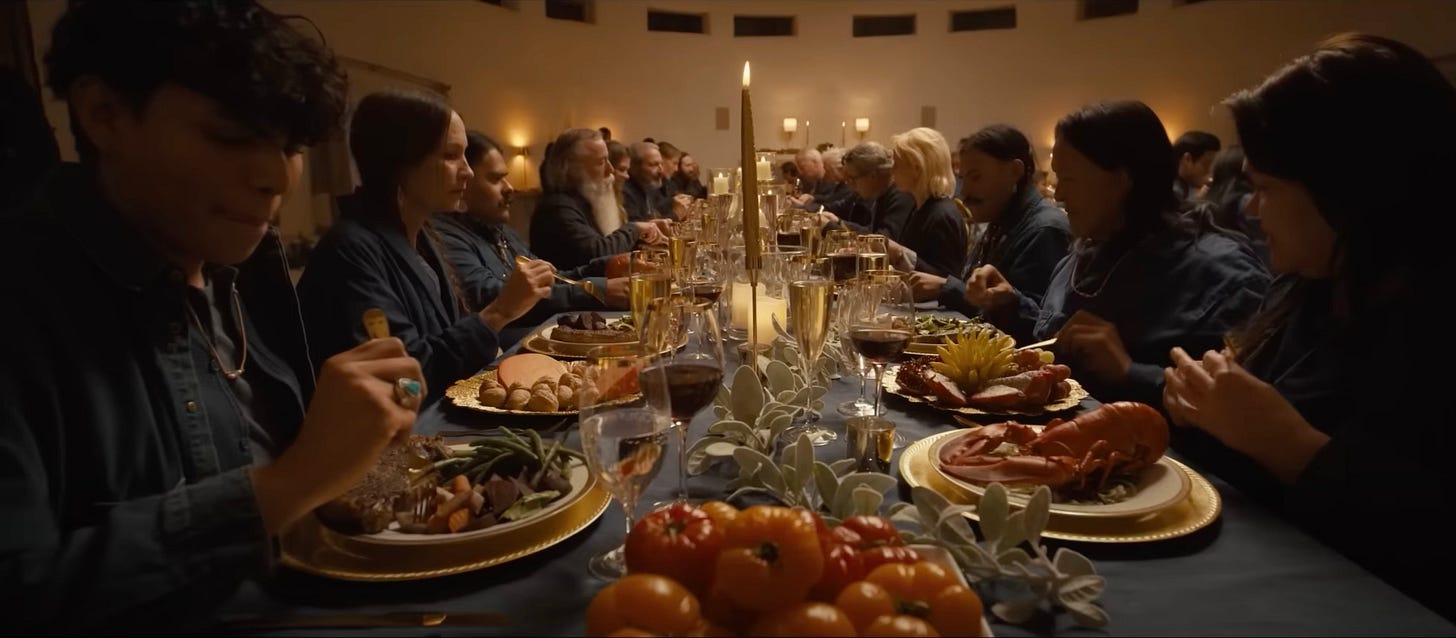So I recently wrote an article for my actual job about Mickey 17 and why Ylfa (Toni Collette’s character) is so obsessed with sauce and how food is a very clear presentation of class differences in that film. While it wasn’t within the scope of that particular article for me to explore the topic with much depth beyond that singular movie, it really got me thinking about the convergence between how films choose to represent food and class and how current popular brands have turned to using food as a status symbol in their marketing.
I am by no means the first person to catch on to the current connection between luxury brands and sensory marketing, nor am I probably the most thorough to explain it from a marketing perspective since that is simply not my area. But, as a gen-z consumer and a regular social media user, I have seen my fair share of these campaigns. Some of the most obvious examples that I have seen are luxury companies like Jacquemus or skincare brands like Rhode that sell a lifestyle as much as a product. And just like in the movies that I want to talk about today, that lifestyle is all about luxury.
Immediately after its release, I went to see Mickey 17 and just a few days later I saw Opus both of which struck me as being heavily centred around ideas surrounding status and fame, and in both instances I was highly aware of the use of food in those films as well.
Mickey 17 might be the clearer example because Ylfa is quite literally always talking about sauce and the taste that one needs to have to fully appreciate it. She relates this sense of taste directly to class status and her role as the wife of the space ship’s charismatic leader/dictator (played by Mark Ruffalo). In separate scenes viewers are shown the food that the average inhabitants of the ship eat versus what Ylfa and her husband eat, and I would say that Bong Joon Ho is making a pretty clear point there.
To a slightly less obvious extent, I would say that very charged imagery surrounding food is also present in Opus, specifically during the dinner scene in Moretti’s (John Malkovich) compound. The most striking part of the scene is when the characters at one end of a table are given a loaf of bread and instructed to eat one bite and pass it on, leaving only the gnawed at centre by the time the last individuals received it. This is quickly followed by everyone receiving their own lavish and unique meals that point toward the wealthy status of the cult.
It is impossible to watch either of these films without noticing the presentation of food and how such food relates to the statuses of the characters, even if the movies are not explicitly about food. Without spoiling too much of either film, it is clear that the ability to obtain and regularly eat nice food for the main villains in each film is something that they see as their right. The purpose, then, of including such imagery when other types of status symbols could make the point of class equally, feels like an intentional one in today’s climate.
Let’s be honest, things aren’t great. Basically every single time I speak to any of my friends (who are all in the 20-30 range), we all note how expensive everything is and how terrible the job market is. At this point, shrugging and blaming the cost of living crisis just isn’t enough. Even going out to eat or getting takeout seems like a luxury. When things such as access to healthy, nutritious food seem like a privilege, of course it is going to stand out that luxury brands use precisely this type of food in their marketing.
I would argue that this is for two intertwined reasons. One: it subtly links the brands to the ability to buy and then waste food resources that not everyone might have access to, therefore showing class privilege. And two: it promotes those products to a very specific and aspirational type of consumer. For example, depicting fresh squeezed orange juice or freshly baked bread appeals to individuals who either have the money to buy that version of the food rather than a less expensive version or who have the time to make those things themselves.
“using fresh fruits or decadent desserts to market products conjures up an extremely different imagined consumer than a burger and fries”
This analysis might seem a bit extreme to the majority of people seeing sensory and food based ads and interacting with them without a second thought. But think about it for an extra second and it becomes pretty clear that using fresh fruits or decadent desserts to market products conjures up an extremely different imagined consumer than a burger and fries. So, to return to my original point about the role that recent movies have played in my thoughts on this matter, seeing food come up more as an explicit critique of class inequality in film indicates that this notion is really becoming a broader and broader trend.
While rich people being out of touch with what average people eat and average people seeing those foods as a luxury is certainly nothing new, it is interesting to see which foods exactly have become markers of status and how those already in power continue to capitalise on food inequality through marketing. And with the political, social, and economic situation of the US not looking like it will change course anytime soon, it seems likely that we will continue to see seemingly basic foods as status symbols for the foreseeable future.







Really enjoyed the post Emily. I look forward to reading more of your articles in the future. I'm reminded of a quote I read recently. "Food is not rational. Food is habit, craving and identity." by Jonathan Safran Foer. Craving is brought on by current situations. When it is snowing and cold out we seek comfort food like vegetable soup and fresh baked bread. When we have sunshine we enjoy lavish salads and crackers with warm cheese and a jar of olives. I like to get inspiration from Allrecipes.com. Hope to see more of your articles. Just finished The Little Liar By Mitch Albom. Enjoyable and rather pertinent in these current times.